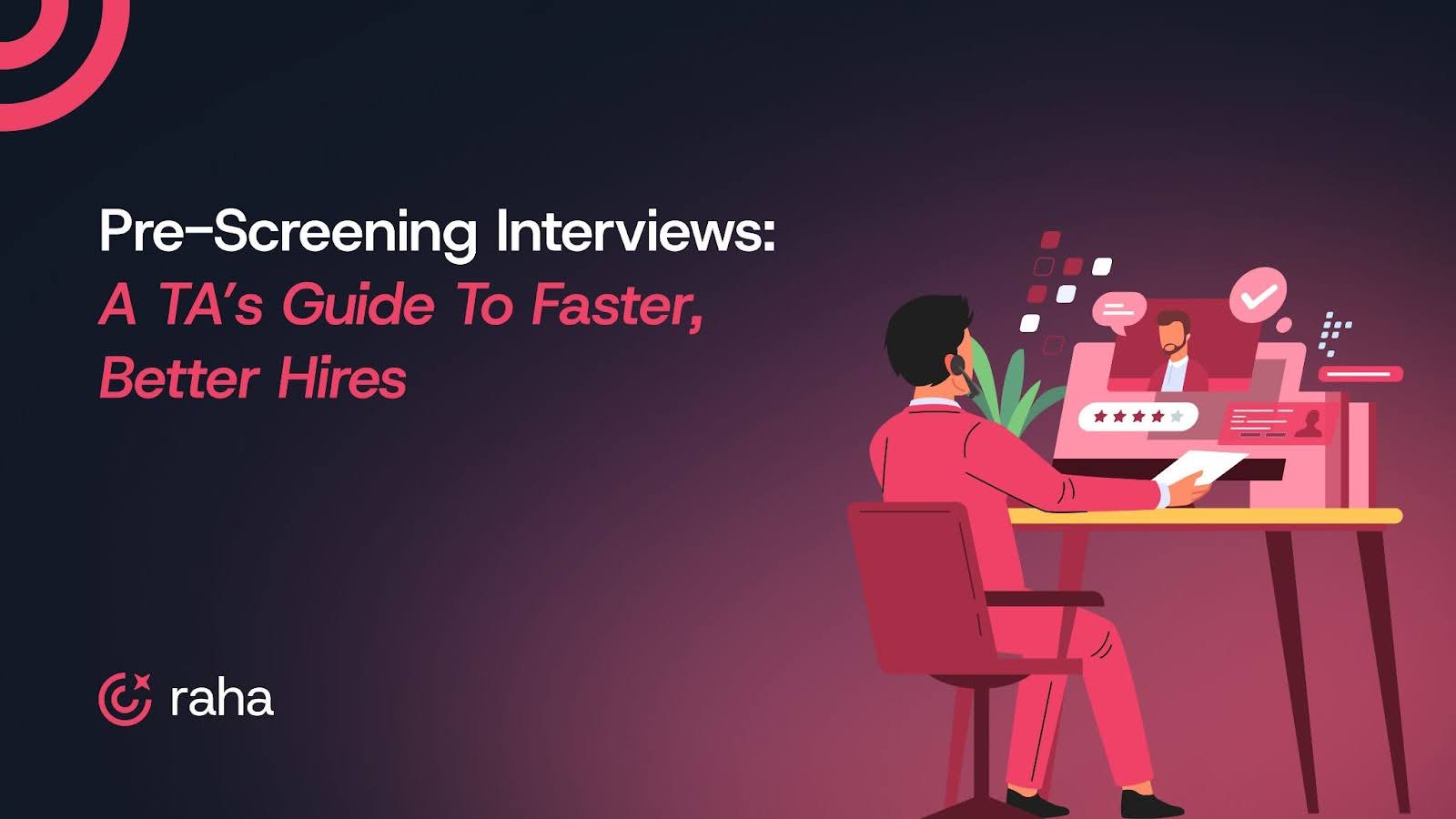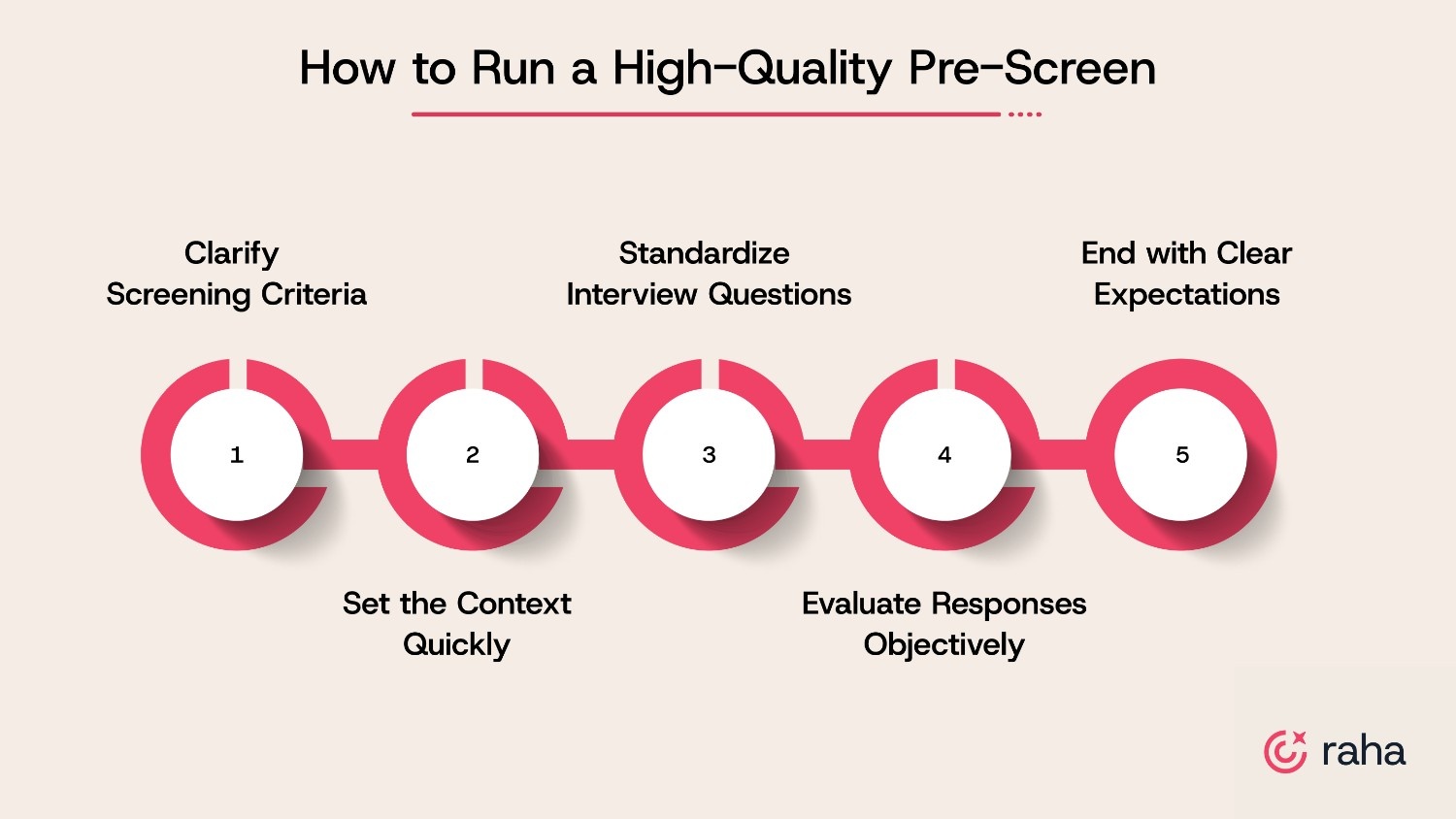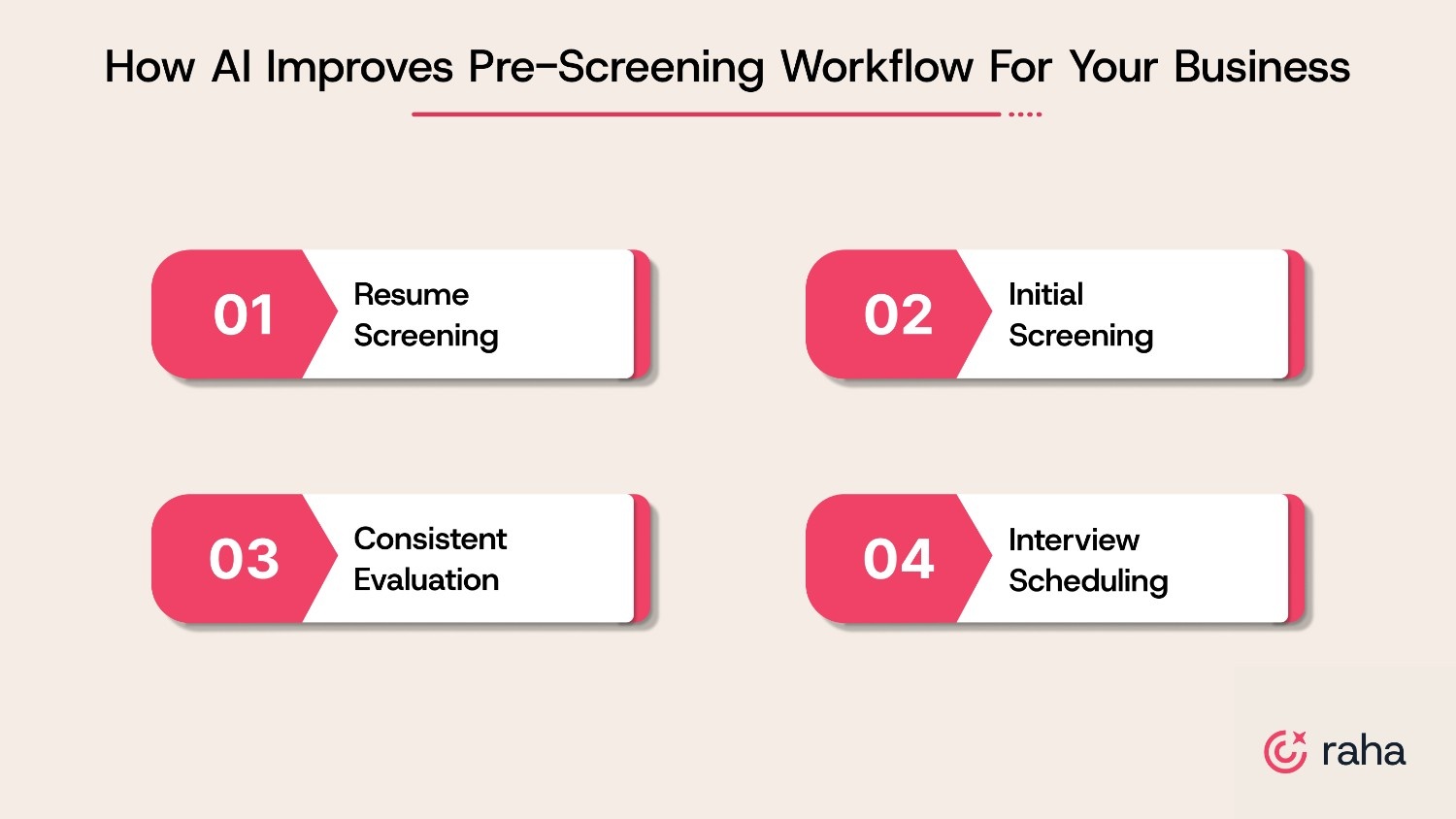
Pre-screening sounds simple: a quick call to confirm basics and move people through. But in practice, this step can make or break the entire hiring process.
If you get it right, pre-screening filters fast, sets clear expectations early, and protects your team’s time. If you get it wrong, you flood the funnel with the wrong people and slow down everything that follows.
The real issue here is that too many pre-screens become default, unstructured, or rushed. That’s when key signals get missed and gut feel takes over.
In this guide, we’ll walk through how to run sharper pre-screening interviews, what questions to ask, and how to use tools (including AI) to do it all faster without losing quality.
Quick look:
- Pre-screens help you catch red flags early and surface intent, communication, and motivation.
- Structured questions tied to role fit, motivation, and logistics lead to faster, evidence-based calls.
- Consistent scoring and repeatable evaluations reduce bias and make decisions easier to defend.
- Good pre-screens align tightly with hiring criteria and generate notes that actually move candidates forward.
- AI automates the busywork so you can screen faster, move smarter, and fill roles without growing your team.
What is a Pre-Screening Interview?
A pre-screening interview is the first real filter in your hiring process. It’s where you quickly assess whether a candidate has the baseline qualifications, expectations, and motivation to move forward before investing time in a full interview loop.
It typically happens over a phone call or an async AI screen and covers things like salary expectations, notice period, work eligibility, and role alignment.
A pre-screening interview gives you a chance to:
- Catch dealbreakers early.
- Sense communication style.
- Understand motivation beyond the resume.
For example, a candidate looks great on paper but mentions they’re exploring multiple offers and need remote flexibility. That’s valuable context. Or someone with less obvious experience explains how they’ve solved the exact problem your team is hiring for—that’s a signal to move them forward.
Top Screening Interview Questions to Ask Candidates
These aren’t your standard “tell me about yourself” questions. The goal here is to ask with intent: to uncover fit, clarity, and motivation early, without dragging unqualified candidates through your funnel. Here’s how to approach it by category:

1. Motivation & Intent
Use these questions early in the call to understand whether a candidate is casually browsing or intentionally exploring. Motivation gives context to every other answer and reveals how likely they are to accept your offer if things move forward.
Sample Questions:
- Why are you exploring new opportunities right now?
- What are you looking for in your next role?
- What motivated you to apply for this specific position?
- Where do you see yourself in the next couple of years?
- What’s missing in your current role that you're hoping to find here?
What to listen for:
- Clear indicators of intent, such as wanting to grow in a specific area or seeking a role that aligns with long-term goals
- Vague or passive responses, like “I just want a change”. These often lack depth and signal low commitment
Follow-up tactic: Ask, “What prompted you to apply to this role specifically?” to assess alignment and effort.
2. Role Fit & Experience Match
This is where you map a candidate’s skills and past work to the actual requirements of the role. Probe for the scope, ownership, and outcomes of their experience.
Sample Questions:
- Can you walk me through your current role?
- What kinds of projects have you owned directly in the last 6–12 months?
- What core skills have you developed that you think are most relevant here?
- Tell me about a challenge you’ve faced in your last role and how you handled it.
What to listen for:
- Direct relevance to the role’s top 2–3 priorities, not just generic experience
- Clear examples of ownership, not just participation
Follow-up tactic: Ask, “What would you need to ramp up quickly in this role?” to uncover both readiness and growth areas.
3. Communication & Clarity
With these questions, you’re looking for clarity of thought, how they structure ideas, and how well they understand their own work.
Sample Questions:
- How do you typically approach [a task relevant to the role]?
- Can you explain a project you’re proud of and why it mattered?
- How do you prioritize your work when juggling multiple deadlines?
- When was the last time you had to adjust your approach mid-project?
What to listen for:
- Structured, thoughtful responses that show depth, not rehearsed answers
- Ability to explain the “why” behind their actions, not just the “what”
Follow-up tactic: Ask, “If you had to do that project again, what would you change?” to reveal reflection and a growth mindset.
4. Practical Constraints
No one likes wasting time. Address logistics early so you know if there are blockers before moving to deeper stages.
Sample Questions:
- What’s your notice period or availability to start?
- What are your location preferences or expectations around remote work?
- Are you open to relocation if the role eventually requires it?
- Are you actively interviewing elsewhere or working with timelines we should be aware of?
- Do you have any non-negotiables when it comes to work setup, compensation, or hours?
What to listen for:
- Any non-negotiables that would block the process
- Willingness or ability to align with your setup, especially important for time zones, hybrid policies, or shift-based roles
Follow-up tactic: Ask, “Is there anything that would prevent you from accepting an offer if all else aligned?”
Also read: The Only Interview Questions You’ll Need For Your Next Hire
How to Run a High-Quality Pre-Screen
Pre-screening interviews are fast-paced, structured, and built for signal over fluff. But to get the most out of them, you need a repeatable system. Here's how experienced recruiters run them:

1. Align on What You're Screening For
Before you even dial in, clarify what success looks like. Are you validating
- Baseline qualifications?
- Communication skills?
- Role motivation?
- Alignment with comp expectations?
Decide with the hiring manager what matters at this stage and stick to it.
Tip: Avoid the “just getting to know them” trap. Every pre-screen should map back to a real hiring requirement.
2. Set the Context Quickly
Start with a concise intro:
- Who you are
- The structure of the call
- What they can expect post-interview
This builds trust and helps the candidate relax. It also frames the conversation as a two-way street, not just an interrogation.
3. Ask Structured, Repeatable Questions
Consistency is key if you want a fair comparison. Ask the same core questions across candidates, especially for role fit, experience validation, and motivation. Add light customization, but avoid reinventing your script each time.
Mix in:
- Resume-based questions to confirm what’s on paper
- Role-specific fit and motivation
- Potential flags around location, salary, notice period, or clarity on the role
4. Evaluate Responses Objectively
Pre-screens only add value if they’re paired with a structured, repeatable way to assess answers. Without that, bias or gut feel can creep in, especially when you're moving fast.
What to do:
- Use a scoring rubric aligned with the core requirements (skills, experience, motivation, communication)
- Write down key phrases or examples during the call, not just an overall impression
- Look for consistency and patterns across answers, not just one standout moment
- Flag unclear or inconsistent responses for follow-up in later rounds
Common mistakes to avoid:
- Letting likability override substance
- Failing to probe vague or surface-level responses
- Not aligning your notes with hiring criteria, especially if you’re not the final decision-maker
5. End with Clear Expectations
Even if it’s a quick pass or a step forward, close with clarity. Let the candidate know what to expect and when. It shows professionalism and helps avoid ghosting on both sides.
How AI Improves Pre-Screening Workflow For Your Business
Pre-screens are where great candidates often get lost. Resumes buried, signals missed, and hours burned on repetitive tasks. If your team is still manually reviewing resumes, juggling intro calls, or chasing schedules, you're slowing down and risking quality.
Here's how AI, when built for recruiting, actually fixes the workflow.

1. AI Takes the Resume Load Off Your Plate
You manually scan resumes, hunting for relevant experience or keywords. It’s repetitive, error-prone, and strong candidates get overlooked due to formatting or phrasing mismatches.
With Raha AI:
Raha is your AI-powered recruiting assistant. It’s AI Resume Screener parses every resume into structured, comparable data. You get a clean candidate sheet with skill breakdowns and an automatic fit score. You can filter instantly and spot top candidates faster without losing the signal in the noise.
What it improves:
- Screen candidates 10x faster
- Top candidates aren’t lost in the noise
- Recruiters spend more time engaging, not filtering
2. AI Runs First-Round Screens for You
You or someone on your team has to manually call candidates for a quick-fit check. This means juggling schedules, repeating the same intro questions, and trying to take decent notes in real time. It slows everything down.
With Raha AI:
Raha’s AI Interviewer autonomously handles the first-round call. It asks 7–10 tailored questions, speaks to the candidate, and generates a structured report with highlights, patterns, and a fit score.
What it improves:
- Better signal upfront, before humans join the loop
- No more chasing notes or repeating questions
- Moves candidates from apply to interview in under 5 minutes
3. AI Makes Candidate Evaluation More Consistent
Even with a structured interview, evaluations are often based on gut feel. TAs may forget to align answers to hiring criteria, miss patterns across questions, or get swayed by one charming response.
With Raha AI
Every response is assessed against the same rubric. Raha flags inconsistencies, summarizes themes, and scores candidates on communication, motivation, and fit, all backed by evidence.
What it improves:
- Fewer bias-driven decisions
- Fairer, faster shortlists
- Stronger alignment between TA and hiring managers
4. AI Handles Interview Scheduling — Fully
Scheduling is a painful loop. You chase candidates, hiring managers, and panelists for availability. Reschedules and no-shows eat up hours. RCs get stuck in email chains instead of optimizing hiring operations.
With Raha AI:
Raha’s AI Interview Coordinator manages the full interview scheduling process end-to-end. It integrates with your ATS, calendar, and email tools, handles outreach to all stakeholders, manages follow-ups, and resolves conflicts or reschedules automatically, without RC involvement.
What it improves:
- Speeds up coordination by 84%
- Reduces dependency on TA Ops
- Automates 90% of interview management tasks
With Raha AI, your team can handle volume without burnout. You scale hiring without scaling headcount — and fill roles 15 days faster.
Also read: How AI Candidate Screening Speeds Up Hiring and Improves Fit
Ready to Run Smarter Pre-Screens?
Pre-screening interviews are one of your highest-leverage tools. It’s where you set alignment early, catch red flags, and keep top candidates moving forward.
But too often, they turn into a checkbox call that adds time without adding clarity.
With sharper questions and a clear structure, pre-screens become a reliable filter that improves every stage after. And with Raha AI handling resume parsing, fit scoring, and first-round screening calls, you can move faster and make better calls from the start.
FAQs
1. What is pre-screening in hiring?
Pre-screening is the early-stage filtering process used to assess if a candidate meets basic role requirements like experience, salary expectations, work eligibility, and motivation before advancing to full interviews.
2. How long should a pre-screening interview last?
A pre-screening interview typically runs between 10–30 minutes. The goal is to efficiently qualify candidates without turning it into a full interview loop.
3. Who conducts a pre-screening interview?
Mostly, recruiters or TA team members conduct the pre-screening. It can also be handled by automated AI tools, depending on your hiring setup.
4. Should pre-screening include salary and availability questions?
Yes. It's critical to cover salary expectations and availability early to prevent mismatches later in the process and avoid wasted time on candidates who don’t align.
5. Are pre-screening interviews the same across roles?
Not necessarily. While the format stays consistent, the core questions like motivation, role match, or logistics should adapt based on the specific technical, leadership, or functional requirements of the position.

